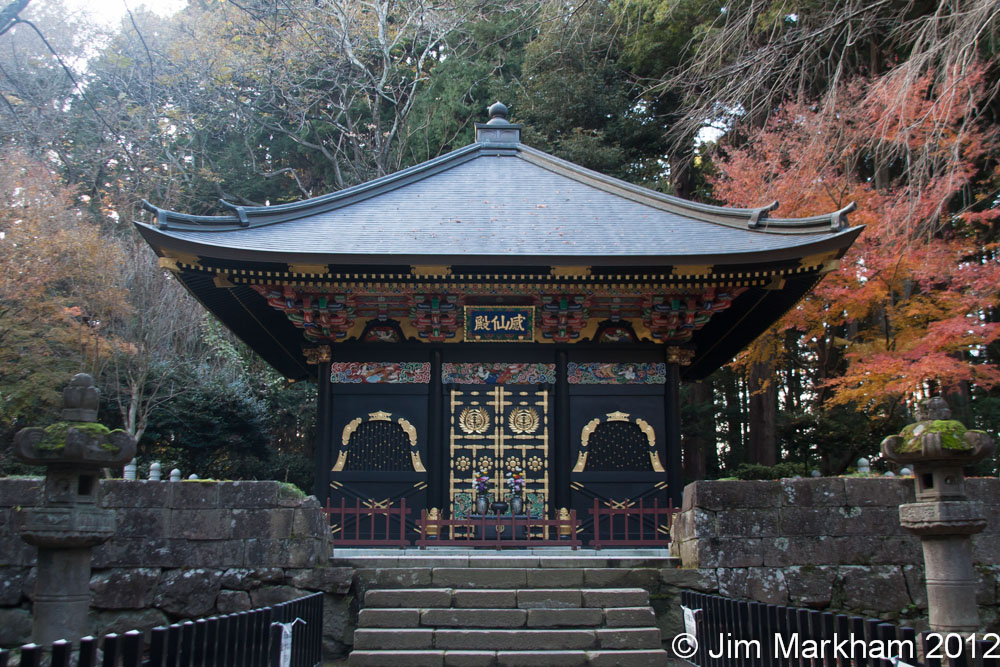
So next up in my series on the YS63 TDY to Japan are the photos and reflections on the cultural exposure tour (and assorted other tangents). On the way to Sendai from Narita Airport, it’s pretty much impossible for one to miss the largest statue in Japan (3rd largest in the world):
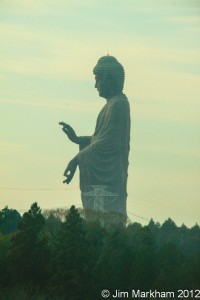
At 394′ tall, the Ushiku Daibutsu is 2 1/2 times the height of the Statue of Liberty. There’s another huge statue located outside Sendai, but apparently that one was built as a tax write-off in the ’80’s by a now defunct company, and is not very popular with the locals:
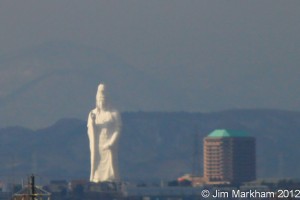
Once we got on ground at Camp Sendai, we were somewhat disappointed that the cultural tours had all filled up before we got there. However, since there were enough people who came in 2 days before the exercise, they added some tours, and we managed to get our names on the list. The bus started out by driving out to the area affected by the March 2011 tsunami, and that was quite a humbling experience. On the way down, we crossed a canal, and the water pipes there still showed evidence of the wave’s onslaught:
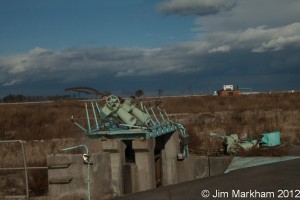
There were a couple of solitary houses which for unknown reasons managed to survive:
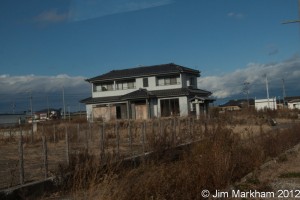
The place we stopped was a WWII memorial which had been built on a hill. In front of the hill they had some small bulletin boards with pictures of what the memorial looked like before the tsunami, and immediately afterward:
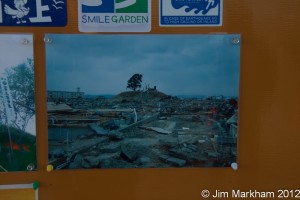
Here’s what the place looked like when we rolled up:
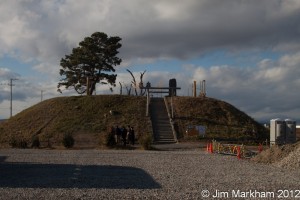
Note the wooden ‘gateway’ which was built halfway up the stairs to replace the stone one which had been there originally. The stone gateway was snapped off by debris carried by the wave:
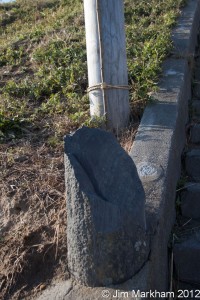
If it seems like I’ve been drawing this out, I have. The last photo I’ll share from the site is a panorama I took with my iPhone. To say that the destruction there was total, utter, and complete, wouldn’t even begin to describe it. Knowing how lax some of the response was in Honolulu to the tsunami warning we got in October, and then seeing this, I will never ‘hang around to see what happens’ should the warning sirens go off. The waves are still visible in the distance, and it looks not too dissimilar to the waves out on the North Shore here in Hawaii. They’ve moved out all of the debris, but looking at this scene and then realizing that it had once been a densely populated neighborhood (note the house foundations and fence/wall bases)… it’s a bit overpowering:

After leaving the tsunami site, the bus took us through lower Sendai to the Zuihoden mausoleum, burial site of Date Masamune (Masamune being his given name, and Date being his ‘last name’ in western-style naming convention). Masamune was a powerful daimyo at the end of the 16th century, which meant he held lordship over an area given to him by the Shogun (military rulers of Japan until 1868, when imperial rule re-emerged). Specifically, toward the end of his life Masamune was lord over the Sendai region, which he improved into a major trading area through Sendai port. On the Zuihoden site there are the tombs of Masamune and the next 2 Date lords. The street arrival area is at the bottom of the hill, and large stone staircases lead up to the site. Even this late in the year, the trees were very, very colorful, which made for some great pictures. Yes, I was actually there:
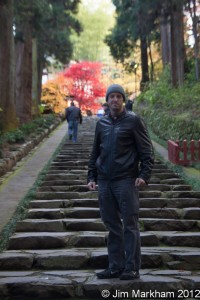
As I said, the trees were especially beautiful, kinda reminded me of Vermont:
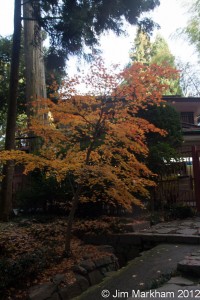
At the entry, there was a Temizu basin, used for ritual cleansing. From Wikipedia: If there is a hand washing basin provided, perform Temizu: take the dipper in your right hand and scoop up water. Pour some onto your left hand, then transfer the dipper to your left hand and pour some onto your right hand. Transfer the dipper to your right hand again, cup your left palm, and pour water into it, from which you will take the water into your mouth (never drink directly from the dipper), silently swish it around in your mouth (do not drink), then quietly spit it out into your cupped left hand (not into the reservoir). Then, holding the handle of the dipper in both hands, turn it vertically so that the remaining water washes over the handle. Then replace it where you found it.
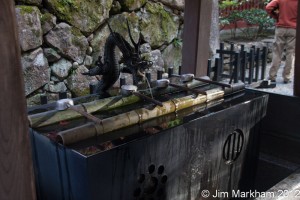
The as the ritual was explained to me it involved spitting in the trough around the basin instead of in my hand, which at least in my head was more ‘cleansing’ than the version from wikipedia 😉
Just before we entered the walled-off courtyard in front of the first mausoleum, we got overflown by some particularly quick birds: Hayabusa!
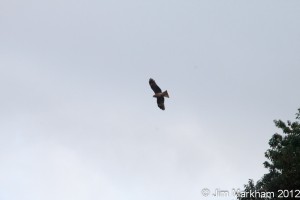
(Hayabusa is simply the name for the Japanese sub-species of the Peregrine Falcon, but being a bike-nut I figured I’d include it)
It took a couple of shots stitched together since 18mm just isn’t wide enough for WIDE shots, but I still managed to get a decent image of the building:
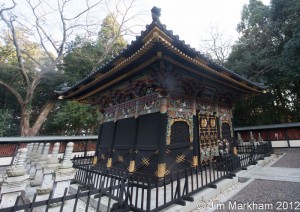
The wooden buildings burned down in allied attacks during WWII, but were rebuilt afterward. In the courtyard between the above building and the entrance there was a museum which housed artifacts from the Date-clan period. Interestingly, the life-size replica of Masamune’s armor revealed that while he may have been a large man in his day, he was relatively short by even modern Japanese standards. He was known as the ‘One-Eyed Dragon’, a nickname he earned due to having lost an eye in childhood to smallpox. Pictures aren’t allowed inside the museum, but it was definitely worth walking around:
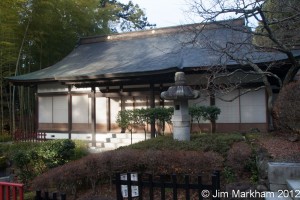
Through the woods facing the first mausoleum were two more, which were set apart from their surrounding walls a bit more, allowing better sight-lines for pictures:
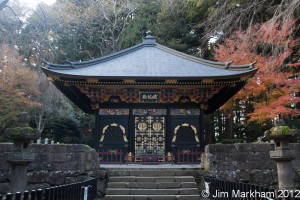
In the courtyard in front of the two other buildings (the 3rd lord’s tomb was to the left of the one pictured above) were a large number of stone lanterns, which were arranged such as to make for some good pictures:
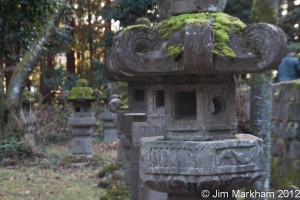
Back at the bottom of the hill, there was an kindergarden:
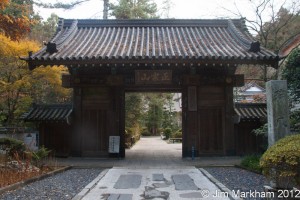
The next site was more of a ‘tourist’ stop, in that there were a number of shops nearby, but the purpose of the stop was to see the site Masamune’s Sendai Castle had once stood. Looking back down from the overlook, I can see why someone in the late 1500s would build a stronghold here. You can see all the way down to the shore where we had started the day:
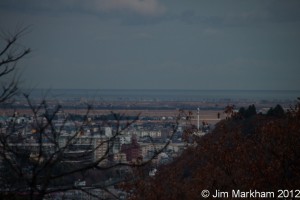
The sky made for a great self-portrait to cap off the day:
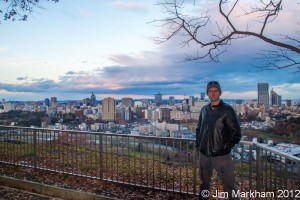
Next post: Stumbling through Sendai.
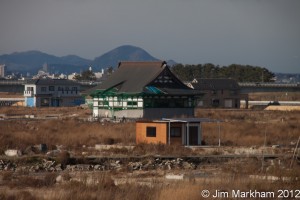

Leave a Reply